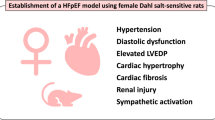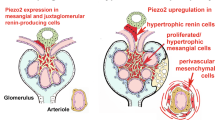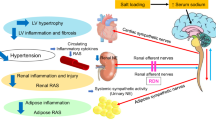Abstract
Thiazolidinediones, which stimulate peroxisome proliferator–activated receptor γ, have been shown to prevent cardiovascular injury. However, little is known about their effects on salt-sensitive hypertension. We thus investigated whether or not pioglitazone affects left ventricular (LV) hypertrophy in Dahl salt-sensitive rats, then compared its effects to those of an angiotensin II receptor blocker, candesartan. Rats were used at 16 weeks of age after they had been fed either a low-salt (0.3%; DSL) or high-salt (8%; DSH) diet for 10 weeks; some of the DSH rats were treated with pioglitazone (10 mg/kg/day) or candesartan (4 mg/kg/day). Both drugs decreased the elevated blood pressure in DSH rats, although it was still higher than in DSL rats. Both drugs decreased plasma insulin levels, but neither affected plasma glucose levels. The thiobarbituric acid reactive substance level in the LV was decreased by both drugs. LV hypertrophy evaluated by echocardiography in DSH rats was nearly normalized by both drugs, whereas only candesartan decreased LV diameter. In histological analysis, both drugs ameliorated LV fibrosis and myocardial cell hypertrophy. Both drugs decreased elevated gene expression levels of transforming growth factor-β1 and collagen type I, although the pioglitazone action was slightly modest. The metalloproteinase activity was increased in DSH rats, but both drugs decreased this level. Taken together, these findings indicate that pioglitazone reduced LV hypertrophy and fibrosis in salt-sensitive hypertension. Improvement in blood pressure, insulin level, and oxidative stress may be associated with this beneficial action of pioglitazone.
Similar content being viewed by others
Article PDF
References
Devereux RB, Wachtell K, Gerdts E, et al: Prognostic significance of left ventricular mass change during treatment of hypertension. JAMA 2004; 292: 2350–2356.
Gosse P : Left ventricular hypertrophy as a predictor of cardiovascular risk. J Hypertens Suppl 2005; 23: S27–S33.
Selvetella G, Hirsch E, Notte A, Tarone G, Lembo G : Adaptive and maladaptive hypertrophic pathways: points of convergence and divergence. Cardiovasc Res 2004; 63: 373–380.
Frey N, Katus HA, Olson EN, Hill JA : Hypertrophy of the heart: a new therapeutic target? Circulation 2004; 109: 1580–1589.
Rysa J, Leskinen H, Ilves M, Ruskoaho H : Distinct upregulation of extracellular matrix genes in transition from hypertrophy to hypertensive heart failure. Hypertension 2005; 45: 927–933.
Iwanaga Y, Aoyama T, Kihara Y, Onozawa Y, Yoneda T, Sasayama S : Excessive activation of matrix metalloproteinases coincides with left ventricular remodeling during transition from hypertrophy to heart failure in hypertensive rats. J Am Coll Cardiol 2002; 39: 1384–1391.
Ahmed MS, Oie E, Vinge LE, et al: Connective tissue growth factor—a novel mediator of angiotensin II–stimulated cardiac fibroblast activation in heart failure in rats. J Mol Cell Cardiol 2004; 36: 393–404.
Powell DW, Mifflin RC, Valentich JD, Crowe SE, Saada JI, West AB : Myofibroblasts. I. Paracrine cells important in health and disease. Am J Physiol 1999; 277: C1–C9.
Polyakova V, Hein S, Kostin S, Ziegelhoeffer T, Schaper J : Matrix metalloproteinases and their tissue inhibitors in pressure-overloaded human myocardium during heart failure progression. J Am Coll Cardiol 2004; 44: 1609–1618.
Spinale FG : Matrix metalloproteinases: regulation and dysregulation in the failing heart. Circ Res 2002; 90: 520–530.
Sakata Y, Yamamoto K, Mano T, et al: Activation of matrix metalloproteinases precedes left ventricular remodeling in hypertensive heart failure rats: its inhibition as a primary effect of angiotensin-converting enzyme inhibitor. Circulation 2004; 109: 2143–2149.
Yamamoto K, Mano T, Yoshida J, et al: ACE inhibitor and angiotensin II type 1 receptor blocker differently regulate ventricular fibrosis in hypertensive diastolic heart failure. J Hypertens 2005; 23: 393–400.
Nagata K, Obata K, Xu J, et al: Mineralocorticoid receptor antagonism attenuates cardiac hypertrophy and failure in low-aldosterone hypertensive rats. Hypertension 2006; 47: 656–664.
Schiffrin EL, Amiri F, Benkirane K, Iglarz M, Diep QN : Peroxisome proliferator–activated receptors: vascular and cardiac effects in hypertension. Hypertension 2003; 42: 664–668.
Mukherjee R, Jow L, Croston GE, Paterniti JR Jr : Identification, characterization, and tissue distribution of human peroxisome proliferator–activated receptor (PPAR) isoforms PPARγ2 versus PPARγ1 and activation with retinoid X receptor agonists and antagonists. J Biol Chem 1997; 272: 8071–8076.
Ishibashi M, Egashira K, Hiasa K, et al: Antiinflammatory and antiarteriosclerotic effects of pioglitazone. Hypertension 2002; 40: 687–693.
Inoko M, Kihara Y, Morii I, Fujiwara H, Sasayama S : Transition from compensatory hypertrophy to dilated, failing left ventricles in Dahl salt-sensitive rats. Am J Physiol 1994; 267: H2471–H2482.
Mizukami M, Hasegawa H, Kohro T, et al: Gene expression profile revealed different effects of angiotensin II receptor blockade and angiotensin-converting enzyme inhibitor on heart failure. J Cardiovasc Pharmacol 2003; 42: S1–S6.
Zhao X, White R, Van Huysse J, Leenen FH : Cardiac hypertrophy and cardiac renin-angiotensin system in Dahl rats on high salt intake. J Hypertens 2000; 18: 1319–1326.
Yoshida J, Yamamoto K, Mano T, et al: AT1 receptor blocker added to ACE inhibitor provides benefits at advanced stage of hypertensive diastolic heart failure. Hypertension 2004; 43: 686–691.
Zhou MS, Adam AG, Jaimes EA, Raij L : In salt-sensitive hypertension, increased superoxide production is linked to functional upregulation of angiotensin II. Hypertension 2003; 42: 945–951.
Guo P, Nishiyama A, Rahman M, et al: Contribution of reactive oxygen species to the pathogenesis of left ventricular failure in Dahl salt-sensitive hypertensive rats: effects of angiotensin II blockade. J Hypertens 2006; 24: 1097–1104.
Wake R, Kim-Mitsuyama S, Izumi Y, et al: Beneficial effect of candesartan on rat diastolic heart failure. J Pharmacol Sci 2005; 98: 37237–37239.
Wu L, Wang R, De Champlain J, Wilson TW : Beneficial and deleterious effects of rosiglitazone on hypertension development in spontaneously hypertensive rats. Am J Hypertens 2004; 17: 749–756.
Wakino S, Hayashi K, Tatematsu S, et al: Pioglitazone lowers systemic asymmetric dimethylarginine by inducing dimethylarginine dimethylaminohydrolase in rats. Hypertens Res 2005; 28: 255–262.
Iglarz M, Touyz RM, Amiri F, Lavoie MF, Diep QN, Schiffrin EL : Effect of peroxisome proliferator–activated receptor-α and -γ activators on vascular remodeling in endothelin-dependent hypertension. Atheroscler Thromb Vasc Biol 2003; 23: 45–51.
Iglarz M, Touyz RM, Viel EC, et al: Peroxisome proliferator–activated receptor-α and receptor-γ activators prevent cardiac fibrosis in mineralocorticoid-dependent hypertension. Hypertension 2003; 42: 737–743.
Benkirane K, Viel EC, Amiri F, Schiffrin EL : Peroxisome proliferator–activated receptor γ regulates angiotensin II–stimulated phosphatidylinositol 3-kinase and mitogen-activated protein kinase in blood vessels in vivo. Hypertension 2006; 47: 102–108.
Majithiya JB, Parmar AN, Trivedi CJ, Balaraman R : Effect of pioglitazone on L-NAME induced hypertension in diabetic rats. Vascul Pharmacol 2005; 43: 260–266.
Yosefy C, Magen E, Kiselevich A, et al: Rosiglitazone improves, while Glibenclamide worsens blood pressure control in treated hypertensive diabetic and dyslipidemic subjects via modulation of insulin resistance and sympathetic activity. J Cardiovasc Pharmacol 2004; 44: 215–222.
Derosa G, Cicero AFG, D'Angelo A : Thiazolidinedione effects on blood pressure in diabetic patients with metabolic syndrome treated with glimepiride. Hypertens Res 2005; 28: 917–924.
Ogihara T, Asano T, Ando K, et al: High-salt diet enhances insulin signaling and induces insulin resistance in Dahl salt-sensitive rats. Hypertension 2002; 40: 83–89.
Landsberg L : Insulin sensitivity in the pathogenesis of hypertension and hypertensive complications. Clin Exp Hypertens 1996; 18: 337–346.
Ryan MJ, Didion SP, Mathur S, Faraci FM, Sigmund CD : PPAR(gamma) agonist rosiglitazone improves vascular function and lowers blood pressure in hypertensive transgenic mice. Hypertension 2004; 43: 661–666.
Ishimitsu T, Kobayashi T, Honda T, et al: Protective effects of an angiotensin II receptor blocker and a long-acting calcium channel blocker against cardiovascular organ injuries in hypertensive patients. Hypertens Res 2005; 28: 351–359.
Yu HC, Burrell LM, Black MJ, et al: Salt induces myocardial and renal fibrosis in normotensive and hypertensive rats. Circulation 1998; 98: 2621–2628.
Cucoranu I, Clempus R, Dikalova A, et al: NAD(P)H oxidase 4 mediates transforming growth factor-β1–induced differentiation of cardiac fibroblasts into myofibroblasts. Circ Res 2005; 97: 900–907.
Chen K, Chen J, Li D, Zhang X, Mehta JL : Angiotensin II regulation of collagen type I expression in cardiac fibroblasts: modulation by PPAR-γ ligand pioglitazone. Hypertension 2004; 44: 655–661.
Sugawara A, Takeuchi K, Uruno A, et al: Transcriptional suppression of type 1 angiotensin II receptor gene expression by peroxisome proliferator–activated receptor-gamma in vascular smooth muscle cells. Endocrinology 2001; 142: 3125–3134.
Takeda K, Ichiki T, Tokunou T, et al: Peroxisome proliferator–activated receptor gamma activators downregulate angiotensin II type 1 receptor in vascular smooth muscle cells. Circulation 2000; 102: 1834–1839.
Benkirane K, Amiri F, Diep QN, El Mabrouk M, Schiffrin EL : PPAR-gamma inhibits ANG II–induced cell growth via SHIP2 and 4E-BP1. Am J Physiol Heart Circ Physiol 2006; 290: H390–H397.
Poornima IG, Parikh P, Shannon RP : Diabetic cardiomyopathy: the search for a unifying hypothesis. Circ Res 2006; 98: 596–605.
Duan SZ, Ivashchenko CY, Russell MW, Milstone DS, Mortensen RM : Cardiomyocyte-specific knockout and agonist of peroxisome proliferator–activated receptor-gamma both induce cardiac hypertrophy in mice. Circ Res 2005; 97: 372–379.
Asakawa M, Takano H, Nagai T, et al: Peroxisome proliferator–activated receptor gamma plays a critical role in inhibition of cardiac hypertrophy in vitro and in vivo. Circulation 2002; 105: 1240–1246.
Sakai S, Miyauchi T, Irukayama-Tomobe Y, Ogata T, Goto K, Yamaguchi I : Peroxisome proliferator–activated receptor-gamma activators inhibit endothelin-1–related cardiac hypertrophy in rats. Clin Sci (Lond) 2002; 103 ( Suppl 48): 16S–20S.
Guan Y, Hao C, Cha DR, et al: Thiazolidinediones expand body fluid volume through PPARgamma stimulation of ENaC-mediated renal salt absorption. Nat Med 2005; 11: 861–866.
Nesto RW, Bell D, Bonow RO, et al, American Heart Association, American Diabetes Association : Thiazolidinedione use, fluid retention, and congestive heart failure: a consensus statement from the American Heart Association and American Diabetes Association. Circulation 2003; 108: 2941–2948.
Author information
Authors and Affiliations
Corresponding author
Rights and permissions
About this article
Cite this article
Nakamoto, M., Ohya, Y., Shinzato, T. et al. Pioglitazone, a Thiazolidinedione Derivative, Attenuates Left Ventricular Hypertrophy and Fibrosis in Salt-Sensitive Hypertension. Hypertens Res 31, 353–361 (2008). https://doi.org/10.1291/hypres.31.353
Received:
Accepted:
Issue date:
DOI: https://doi.org/10.1291/hypres.31.353
Keywords
This article is cited by
-
Rethinking pioglitazone as a cardioprotective agent: a new perspective on an overlooked drug
Cardiovascular Diabetology (2021)
-
Interplay between the renin-angiotensin system, the canonical WNT/β-catenin pathway and PPARγ in hypertension
Current Hypertension Reports (2018)
-
Rosiglitazone attenuates activation of human Tenon’s fibroblasts induced by transforming growth factor -β1
Graefe's Archive for Clinical and Experimental Ophthalmology (2012)
-
Pioglitazone inhibits TGFβ induced keratocyte transformation to myofibroblast and extracellular matrix production
Molecular Biology Reports (2011)



